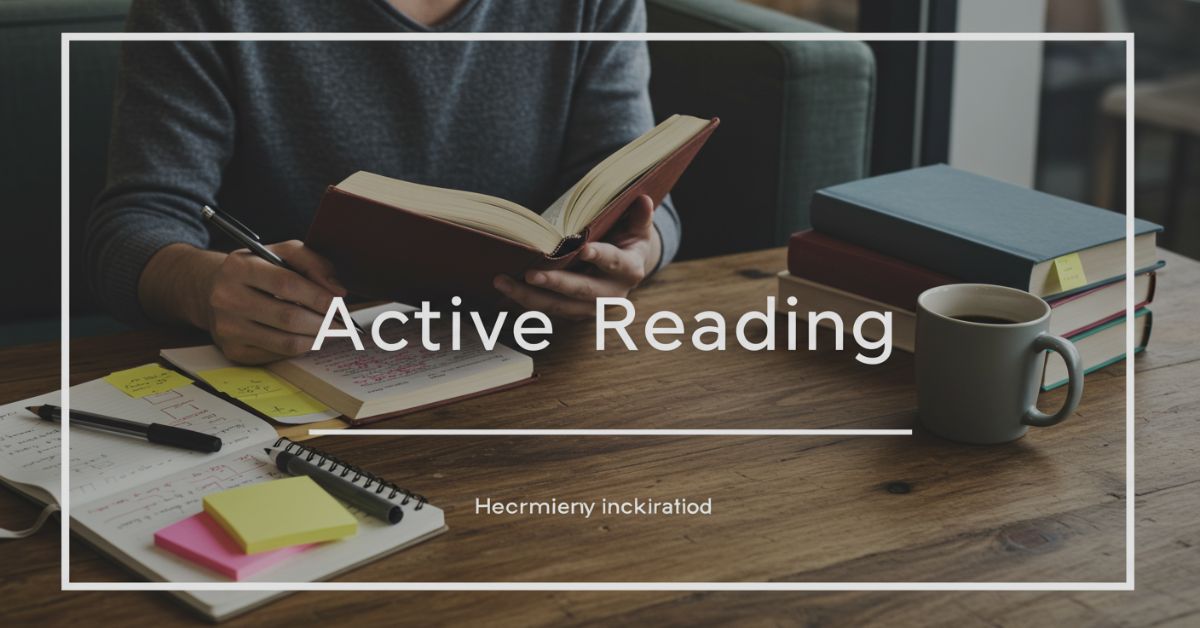Contents
Introduction to Active Reading
Reading is more than just decoding words on a page; it’s an immersive journey that has the power to expand our minds. Yet, many of us skim through texts without truly grasping their essence. That’s where active reading comes into play. Active reading transforms a passive task into an engaging experience by encouraging readers to interact with the material.
Imagine diving deep into a narrative, connecting with ideas, and questioning what you read—all while sharpening your comprehension skills. This approach not only enhances understanding but also fosters critical thinking and retention.
Are you ready to elevate your reading game? Let’s explore how active reading strategies can turn every book, article, or essay into both an adventure and an opportunity for growth.
Benefits of Active Reading Strategies
Active reading strategies transform the way we engage with text. Instead of passively absorbing information, readers become participants in their learning journey.
One significant benefit is improved comprehension. When you interact with the material, it’s easier to grasp complex ideas and retain details.
Another advantage lies in enhanced critical thinking skills. Active engagement prompts questions and deeper analysis, encouraging readers to think beyond the words on the page.
Moreover, these strategies can boost concentration levels. By focusing your mind on specific tasks like summarizing or questioning, distractions fade away.
Increased retention rates also come into play. The more actively you read, the more likely you are to remember what you’ve learned long after closing the book.
Active reading fosters a love for literature by making sessions more enjoyable and rewarding through participation and discovery.
Five Effective Active Reading Strategies
Active reading involves engaging deeply with the text. Here are five powerful strategies to enhance your skills.
Visualization transforms words into images. Picture scenes and characters as you read, creating a mental movie that deepens understanding.
Questioning encourages curiosity. Ask yourself about the author’s intent or the meaning behind certain phrases. This active dialogue keeps your mind engaged.
Summarizing helps distill information into key points. After each section, pause to jot down what you’ve just learned. This reinforces comprehension and retention.
Making connections links new information to personal experiences or other texts. Relating content enhances memory and makes reading more meaningful.
Annotating turns your book into a personalized resource. Highlight, underline, or write notes in the margins to capture thoughts and reactions as you read, fostering an interactive experience that boosts recall later on.
1. Visualization
Visualization is a powerful technique that can transform your reading experience. When you visualize, you create mental images of the concepts and scenes described in the text. This process makes information more vivid and memorable.
Imagine picturing characters in a story or envisioning complex processes as diagrams. This keeps your mind active while also improving comprehension. The act of visualizing allows readers to immerse themselves deeply into the material.
To practice visualization, try closing your eyes for a moment after reading a passage. Picture what you’ve read without looking back at the text. What do you see? How does it make you feel?
By bringing words to life, visualization fosters a deeper understanding of content while making reading an enjoyable activity rather than just a task on your list. As you become skilled at this strategy, expect greater retention and insight from every book or article you tackle.
2. Questioning
Questioning is a powerful tool in active reading. It engages your mind and encourages deeper thinking about the text.
As you read, ask yourself questions. What is the author trying to convey? Are there underlying themes? What connection does this information have to my prior knowledge?
This technique not only keeps you focused but also promotes critical analysis. When you question, you’re more likely to remember details and concepts long after you’ve turned the page.
Consider jotting down your questions as they arise. This can create a dialogue with the text, making it feel more interactive.
Don’t shy away from challenging assumptions or seeking clarity on confusing points either. The act of questioning transforms passive reading into an engaging experience that enhances comprehension and retention significantly.
3. Summarizing
Summarizing is a powerful active reading strategy that helps distill complex information into manageable bites. It encourages you to focus on the essential points of a text rather than getting lost in details.
While reading, pause periodically to ask yourself what the main idea is. What are the key arguments or findings? Jot down these thoughts in your own words. This process enhances comprehension and retention.
Creating concise summaries also sharpens critical thinking skills. It compels you to analyze and evaluate content, making connections between ideas more apparent.
Try summarizing chapters or articles after finishing them. This practice not only reinforces understanding but also provides an excellent reference for future review sessions. You’ll find it easier to recall important concepts when needed. Embracing summarization can significantly enhance your overall reading experience, turning passive consumption into active engagement with texts.
4. Making Connections
Making connections is a powerful active reading strategy that deepens comprehension. When you relate what you’re reading to your own life, other texts, or broader world concepts, the material becomes more meaningful.
Think about personal experiences that resonate with themes in the text. This not only enhances recall but also makes the content relatable and engaging. For instance, if you’re reading about resilience, reflect on times you’ve faced challenges.
You can also link ideas from different books or articles. Recognizing patterns across various works can lead to deeper insights and critical thinking.
Don’t forget to connect with larger societal issues as well. How does the narrative fit into current events or historical contexts? These connections enrich understanding and encourage a more analytical approach to literature.
This strategy transforms passive reading into an interactive experience where knowledge builds upon itself effectively.
4. Annotating
Annotating is a powerful active reading strategy that transforms your interaction with texts. It involves making notes directly on the pages, which enhances comprehension and retention.
As you read, jot down thoughts in the margins. Highlight key phrases or underline important concepts. This process encourages engagement with the material rather than passive consumption.
You can also use symbols to categorize information quickly. For example, stars can indicate crucial points while question marks signal confusion or areas needing further exploration.
Engaging with text through annotations helps clarify complex ideas and fosters critical thinking skills. Plus, revisiting your notes later provides an excellent review tool for exams or discussions.
Don’t hesitate to create a system that works for you—everyone has their unique style! The goal is to make the text come alive and ensure it resonates long after you’ve turned the last page.
Tips for Incorporating Active Reading into Your Daily Routine
Integrating active reading into your daily life can be simple and rewarding. Start by setting aside specific times dedicated solely to reading. Consistency helps cultivate a habit.
Consider creating a cozy, distraction-free space. A quiet corner with good lighting can enhance focus and engagement with the material.
Use technology to your advantage. E-readers often have built-in features that allow you to highlight text or take notes, making it easier to apply active strategies on-the-go.
Mix up your reading materials. Switch between fiction and non-fiction or explore different genres for variety; this keeps your mind engaged and excited about learning.
Try pairing reading with other activities like coffee breaks or commute time. These moments are perfect opportunities to dive into a book while enjoying some downtime.
Overcoming Common Challenges with Active Reading
Active reading can present challenges that might discourage even the most enthusiastic learners. One common hurdle is distraction. Creating a focused environment can help mitigate this issue. Find a quiet space, away from noise and interruptions.
Another challenge is comprehension. When faced with dense texts, it’s easy to feel overwhelmed. Breaking the material into smaller sections allows for better digestion of information.
Time constraints also pose difficulties for many readers. Setting aside just 15 minutes daily can yield significant benefits over time without feeling burdensome.
Some may struggle with motivation. Establishing specific goals or rewarding yourself after completing readings can make the process more enjoyable.
By addressing these obstacles head-on, anyone can enhance their active reading experience and foster greater understanding in their learning journey.
How to Measure Improvement in Reading Skills through Active Reading
Assessing your progress in reading skills can be both rewarding and enlightening. One effective method is to keep a reading journal. Document the titles you’ve read, along with your thoughts and reflections on each piece.
You can also track comprehension through quizzes or summaries after finishing a text. This will help gauge how well you’ve absorbed the material and identify areas for improvement.
Consider participating in discussions or book clubs. Engaging with others about what you’ve read can enhance understanding and reveal new perspectives.
Don’t forget to revisit older texts periodically. Comparing your current interpretations with previous ones offers insight into your growth as an active reader.
Set specific goals for yourself—like increasing reading speed or expanding vocabulary—and monitor these over time. Each small victory contributes to a larger picture of improvement in your overall reading abilities.
Ethan Cole is a versatile writer at hsnime.co.uk, offering fresh perspectives and engaging content across various topics. With a passion for creativity and knowledge, Ethan aims to provide insightful articles that resonate with a diverse audience.






